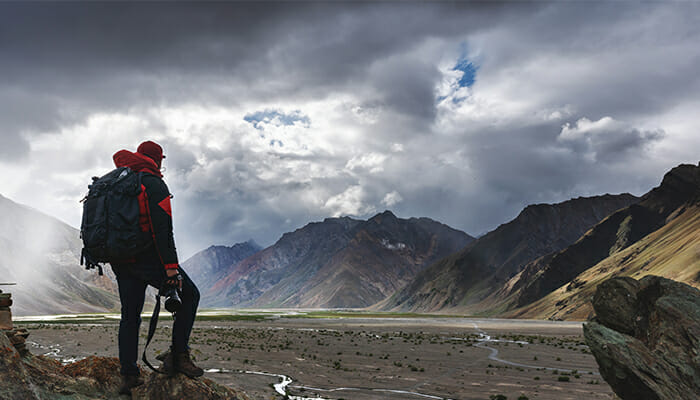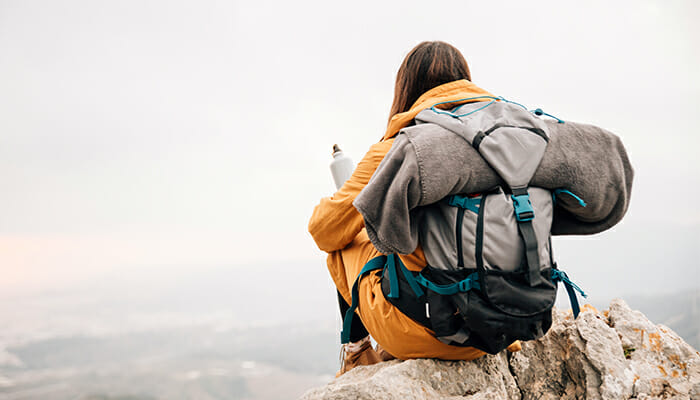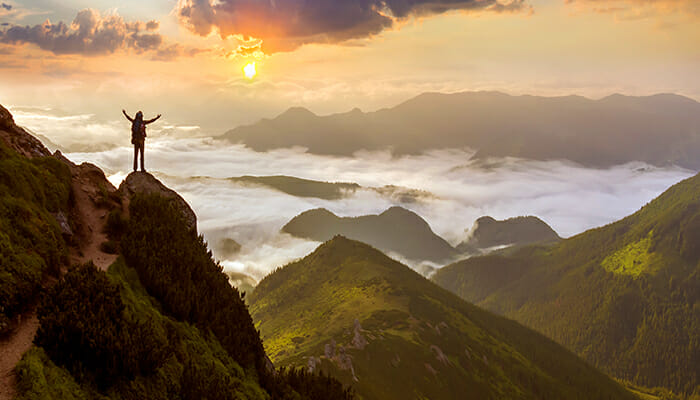Hiking versus trekking. Guide for beginners

If you belong to the category of adventurers who love to be in nature, then hiking or trekking may be activities to your taste. However, although the two activities have a number of elements in common, they are also very different. It is crucial to understand the difference between a hike and trekking, so that you can be sure that you choose the right adventure for you. Therefore, we will try to provide clear explanations in what follows, highlighting the difference between the two.
The essential guide for hiking
What is a hike?
In simple terms, hiking is a recreational activity that involves walking on well-marked man-made paths or roads. The hikes have different degrees of difficulty, but most of the time they are not too strenuous, especially compared to trekking. A hike can last from two hours to a whole day, and the terrain varies from green hills to sloping slopes that pass through forests. Hiking is an adventure that generally does not require you to carry heavy equipment and does not involve the responsibilities of staying overnight.
Who are the hikes for?
Hiking is perfect for people looking for an adventure that will make their heart beat faster, without the need to push their physical limits too much. You will enjoy the open air, walking for long periods of time, sometimes even through rain, hail or sun. Therefore - although the physical requirements of a hike are less demanding than those for a longer adventure - you will still have to be prepared to make some effort.
Hiking in organized groups
Hiking in an organized group involves you more than a trip with the aim of visiting tourist attractions and you can often enjoy a destination tasting a deeper experience, because you are closer to nature and the environment you are visiting. Organized groups involve waking up early in the morning, excellent wildlife photography opportunities, while offering the chance to travel with a group of people with the same concerns and passions, who love to be in nature, just like you. Depending on the type of trip, sometimes you will have to be responsible for setting up a tent and contributing to the preparation of the meal. Other times, you will spend the night in hotels or cabins, everything depends practically on the organization of the trip.
What do you need to know before going hiking?
 There is some vital information that everyone should know before going on a hike. It is important to do serious research on the hiking in the area chosen as a destination and, of course, it is important to test your body and equipment, so that you know what you are capable of and what you can expect.
There is some vital information that everyone should know before going on a hike. It is important to do serious research on the hiking in the area chosen as a destination and, of course, it is important to test your body and equipment, so that you know what you are capable of and what you can expect.
1. Test your equipment . It is better to know how things work before you set off, so that you are not in a situation where they become useless on the route. Do a test with the respective equipment, even in the yard of the house.
2. Avoid cotton. Materials that dry quickly and allow the skin to breathe will be your best friend in nature and will not make you feel uncomfortable if it starts to rain or if it gets too hot.
3. Take enough water and food with you. Most hikers agree that half a liter of water every two hours of walking should be enough. As for food, you'll need to pack about 200 grams for a whole day, plus snacks! Never forget the snacks!
4. Respect. Whether it's about the relationship with other tourists, whether it's about the direct relationship with nature, don't forget that you're just a guest. Pull behind you, be polite, always smile and say hello when you pass other tourists, and don't cause any harm to nature.
5. Try hiking sneakers. Hiking boots are fine, but depending on the route you have to travel, they can do you more harm than good. Sports hiking shoes are becoming a more comfortable and popular option for many of those who go hiking frequently.
6. Share your plans with others . If you are not hiking with an organized group or a team, it is very good to inform those around you about your plans, especially if you are going alone. Announce where you are starting from, where you intend to end the trip and, broadly speaking, what time you will return. It's better to be safe than sorry.
What to put in your hiking luggage?
If you are not sure what to take with you in your luggage for the hike , don't forget to do some research on the location where you are going to arrive. For example, a hike through the Swiss Alps will need a completely different equipment than one in the Amazon.- Appropriate clothing – thermal tops, quick-drying materials, light hoodies, waterproof bands, thermal tights, convertible hiking pants, moisture-wicking hiking socks, a warm hat and light gloves.
- Hiking sticks or walking sticks.
- A comfortable backpack, the size of which will vary depending on the length of the hike.
- Hiking boots or hiking sneakers.
- Cream with sun protection factor or bug spray.
- Cap or sun hat.
- Emergency thermal beds, because if you get lost, they can literally save your life.
- Water and food. Don't forget to take the right amount of water and healthy food with you, such as nuts, seeds, woody mixes and energy bars.
- Toilet paper.
- Plastic bags.
- Mini first aid kit.
- A map.
- Travel insurance.
- Photo camera.
- Binoculars.
- A suitable attitude.
Essential trekking guide

What does trekking mean?
Trekking is similar to a hike, but longer, more difficult and much more involved. And long does not mean just a few hours longer. A trekking route generally lasts two days or more, some of them can even last several weeks. Such trips are more demanding and require superior physical and mental abilities.
Because sometimes you have to walk for whole days, you will have to be in good enough shape to be able to complete the entire trip and be strong enough mentally to push yourself to exceed your limits. While hiking is a recreational activity, trekking is a difficult activity that challenges you and makes you push yourself to the max.
Who is trekking for?
Excursions of this kind are ideal for tourists who try to exceed their limits, living a real adventure, those who enjoy the journey as much as the final destination. They stay focused and involved, keeping the end goal in mind, regardless of the current situation and even when they are tired, they wake up the next morning ready to start all over again!
Trekking in an organized group
Before leaving in an organized group on a trekking route, you must first think about what this experience is like. Unlike hiking, trekking is longer and poses greater difficulties. You will walk for hours, days on end, on difficult terrain. You will most likely stay in a tent, and in many cases you will have to be prepared to set up and take down your tent every morning and night. Depending on the trip, you will have to prepare for different weather conditions.
Some of the most famous treks in the world start in a warm climate and go through rain, wind, snow and dirt. In the case of a trekking, the possibilities are unlimited, so be prepared to live in harsh conditions, this even means going to the toilet in the open air and bathing in rivers. Trekking has nothing to do with glamour, but it is probably one of the most rewarding experiences out there.
What do you need to know before starting on such a route?
 Before going trekking, it is important to do your homework thoroughly. Unfortunately, it's not something you can decide to do on the spur of the moment. Planning, preparation and research are needed. Thus, it is good to take into account the following aspects before going on such a route:
Before going trekking, it is important to do your homework thoroughly. Unfortunately, it's not something you can decide to do on the spur of the moment. Planning, preparation and research are needed. Thus, it is good to take into account the following aspects before going on such a route:
1. Prepare yourself physically . Trekking refers to long and arduous journeys, and your body must be prepared for such a thing. Go to the gym, take lots of short hikes, and eat healthy foods to prepare for the trip. You will thank yourself later.
2. Do a lot of research , especially if you are on the first route of this kind. You need to know everything you can about the weather, about the language, about the food... With so many aspects that need to be taken into account, it is mandatory to take the time to put everything in order.
3. Consider acute mountain sickness (altitude). Many routes are at quite high altitudes, and your body will not be prepared. It is important to give yourself at least two days for acclimatization, so make your reservations with this in mind. In addition, Diamox tablets should be on your list to put in your luggage, in case you have problems with the flu.
4. Get travel insurance . Trekking routes are more risky than simple hikes, and if something goes differently than you planned, you may find yourself in difficult situations. Avoid the risk and make sure you are covered, especially with health insurance for tourists.
5. Learn everything about the tent you are leaving with. The last thing you want is a tent with problems or not knowing your equipment well. You will wear it every night, so it is mandatory to know everything about it.
6. Resume tips for hiking . For the most part, what you need to know before going hiking also applies to trekking. From talking to those around you about your clothes, to avoiding cotton as a material for clothes, be sure to go through the above tips again when you go on long-term trips.
What should the trekking luggage contain?
Just like in the case of hiking, the equipment for trekking depends a lot on the location where you go and the entire route. Do your research thoroughly and find out exactly what you need to have with you. Here's a starting point:- Almost everything on the hiking luggage list.
- The necessary medication for acute mountain sickness. For this you will need to talk to the doctor first.
- Trekking poles.
- Sleeping bag. Invest in a good bag, because it will be hard for you to sleep when you are freezing!
- Isoprene or sleeping mat.
- Toiletries, including shampoo, soap, toothbrush, because you will be gone for days.
- A very good tent.
- Quick drying towel.
- Stove and fuels.
- Bowls and utensils.
- Water purification solutions.
- Compass.
- Many extras arrive.
- Water shoes or flip flops, because after a long day of walking you will need to wear another pair of shoes to give your tired feet a break.
- Lighter and matches.
- Earplugs.
Hiking jargon
Marking - A colored sign, painted or tinted on a tree, with a height of approximately 10 centimeters and a width of 5 centimeters.
Galley - a place where you store equipment, food and other supplies before a long trip.
Step – the lowest point on the ridge between two peaks.
Shortest possible time – the record time for completing a section of the route.
Shelter - a permanent shelter in the middle of the unknown, with four walls and a roof, in which any number of hikers or hikers can sleep, depending on the size.
Salvamont - mountain search and rescue service.
Grohotis – a terrain with loose rocks, smaller in size than the head. It can be a very deceptive surface.

